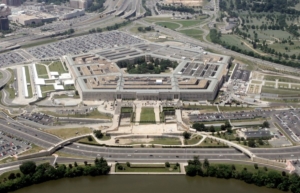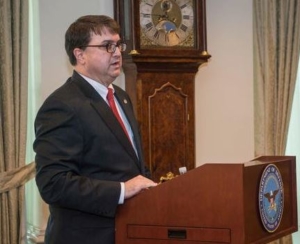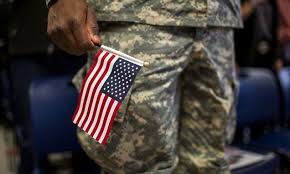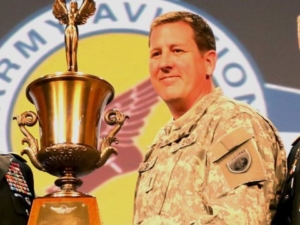
By Debbie Gregory.
On March 9, a video was released that appears to show U.S. Navy pilots encountering an unidentified flying object in 2015.
“Wow, what is that, man?” the pilot says in the video. “Look at that flying!”
“GO FAST is an authentic DoD video that captures the high-speed flight of an unidentified aircraft at low altitudes,” according to the To the Stars Academy of Arts and Science (TTSA), which has mobilized a team of the most experienced, connected and passionately curious minds from the U.S. intelligence community, including the CIA and the Department of Defense.
This is not the first time video has captured an alleged encounters between U.S. Navy pilots and unidentified flying objects.
Retired U.S. Navy Cmdr. David Fravor believes he witnessed a UFO during a routine training mission on Nov. 14, 2004, that “was not from this world.”
He continued: “I’m not crazy, haven’t been drinking. It was — after 18 years of flying, I’ve seen pretty much about everything that I can see in that realm, and this was nothing close.”
Commander Fravor, was flying one of two fighter jets on a routine training mission about 100 miles into the Pacific ocean off San Diego when they were diverted to check out an aircraft spotted on radar from their navy cruiser the USS Princeton.
The operations operator said they had been tracking up to a dozen mystery aircraft over two weeks but hadn’t had manned planes deployed when they showed up.
The object first appeared at 80,000 ft, then hurled towards the sea, stopping at 20,000 feet and hovering before dropping out of radar.
Chris Mellon, a TTSA advisor and former deputy assistant secretary of defense for intelligence in the Clinton and George W. Bush administrations said, “We have no idea what’s behind these weird incidents because we’re not investigating.”
He added, “Nobody wants to be ‘the alien guy’ in the national security bureaucracy; nobody wants to be ridiculed or sidelined for drawing attention to the issue. This is true up and down the chain of command, and it is a serious and recurring impediment to progress.”
The Department of Defense declined to comment on the latest video, but confirmed last December that the U.S. government halted the program for investigating reports of unidentified flying objects after 2012.
Military Connection salutes and proudly serves veterans and service members in the Army, Navy, Air Force, Marines, Coast Guard, Guard and Reserve, and their families.

By Debbie Gregory.
In a change of policy, the Department of Defense (DoD) will start separating perpetually non deployable troops from the military.
The DoD is getting ready to launch a new “deploy-or-out” policy that could possibly force the separation of some 286,000 personnel troops.The service branches have until October 2018 to begin mandatory processing for administrative or disability separation for non-deployable service members
Servicemembers who are classified as “non-deployable” for medical and administrative reasons for more than 12 consecutive months will be processed for administrative separation. Those who are not current on their immunizations, are in the middle of a permanent change of station, who have a medical condition that will take 30 days or more to heal, who are nearing retirement, or who face legal problems can all be classified as non-deployable.
The aim of the policy is to encourage non-deployable troops to seek medical treatment so they can resume their military careers and become deployable as soon as possible.
“If you are going to serve and continue to want to serve, and if you want to make this a career, you’re going to have to learn that path of recovery and get back to being healthy,” said Command Sgt. Maj. John Troxell.
Troops who haven’t been deployable for more than a year will be subject to a go through the medical review board process currently in place, according to Air Force Maj. Carla Gleason, a Pentagon spokeswoman.
“The department intends to emphasize the expectation that all service members are worldwide deployable and to establish standardized criteria for retaining non-deployable service members,” said Maj. Gleason.
The policy does not apply to women who are pregnant or experiencing post-partum conditions, and waivers can be granted to non-deployable troops who are still needed.
Military Connection salutes and proudly serves veterans and service members in the Army, Navy, Air Force, Marines, Coast Guard, Guard and Reserve, and their families.

By Debbie Gregory.
There is no denying that satellites are an important component of our daily lives. Satellites affect our lives without our realizing it: they make us safer, provide modern conveniences, and broadcast entertainment. We get our access to the internet, telephone calls, GPS directions, television and weather from satellites. And that doesn’t even take into consideration how important satellites are to our military.
Our reliance on satellites also makes them a likely target in the event that space becomes a battleground.
Almost half of all operational satellites are owned and operated by the United States government or American commercial companies. That’s twice as many as Russia and China, combined.
U.S. Air Force Brig. Gen. Trent Edwards believes Congress needs to increase defense spending so the U.S. military can better defend against any such attacks, whether they’re aimed at the military or disrupting the private sector.
To that end, Edwards is urging the public to reach out to their representatives in Congress to ask them to pass the Department of Defense budget so the military can take the needed steps to protect the country.
Keeping space systems safe is crucial for the planet, but protection is dispersed among a jumble of overlapping and conflicting authorities. The military and the intelligence communities barely talked to each other for decades on this issue, but last year the Air Force created a Joint Interagency Combined Space Operations Center that will soon have about 200 representatives coordinating operations across agencies.
As the prospect of a war in space becomes more probable, we should start talking about how to avoid that war. To prevent conflict in the upper atmosphere, all potential adversaries—the United States, China, North Korea, Iran, Russia, the EU—need to align, and agree on norms of behavior.
Military Connection salutes and proudly serves veterans and service members in the Army, Navy, Air Force, Marines, Coast Guard, Guard and Reserve, and their families.

By Debbie Gregory.
Robert Wilkie, the Department of Defense’s new undersecretary of defense for personnel and readiness, is shifting the emphasis of the military culture to create a more stable, family friendly environment.
Wilke is responsible for Total Force Management as it relates to readiness; National Guard and Reserve component affairs; health affairs; training; and personnel requirements and management, including equal opportunity, morale, welfare, recreation, and the quality of life for military families.
Wilkie understands that the constant moves made by servicemembers have a direct effect on their family members, limiting the career options of many military spouses, and prohibiting military children from putting down roots with friends and schools.
Wilkie, himself an Army brat, has walked the walk. He said, “If the families aren’t happy, the soldier walks.” Wilkie also serves in the Air Force Reserve.
Under the current system, troops are pushed out of the military if they don’t constantly advance along their career path. Wilkie said the Pentagon has come to the realization that it may need to change how the military operates in order to meet modern threats.
Wilkie credits growing up near Fort Bragg as great preparation for his new position. But he cites the readiness of the military as one of the issues that keeps him up at night. He said new planes are worthless if there are no people to maintain or fly them.
Military Connection salutes and proudly serves veterans and service members in the Army, Navy, Air Force, Marines, Coast Guard, Guard and Reserve, and their families.

By Debbie Gregory.
The Department of Veterans Affairs (VA) provides healthcare to veterans through medical centers and clinics owned and run by the federal government, although veterans can also see private doctors through the Choice if VA wait times are too long. The Department of Defense provides healthcare to current servicemembers, retirees and their families through TRICARE, insurance that is paid for by the government and uses private doctors and hospitals. But soon, the two may be one and the same.
The VA generally serves older, sicker veterans, while TRICARE’s patients are generally healthier.
VA Secretary David Shulkin has been exploring the option of integrating VA and Pentagon health care. This follows the VA’s planned adoption of utilizing a similar electronic health record (EHR) platform as the Defense Department’s MHS GENESIS.
“VA’s adoption of the same EHR system as DoD will ultimately result in all patient data residing in one common system and enable seamless care between the Departments without the manual and electronic exchange and reconciliation of data between two separate systems,” said Shulkin.
Since an overhaul of VA’s EHR won’t be completed for another seven to eight years, a TRICARE merger would more than likely take at least as long.
News of the plan is worrying various veterans groups. The American Legion, Veterans of Foreign Wars, AMVETS and Disabled American Veterans have expressed that a TRICARE merger is likely to be a “non-starter” if the goal is to transform VA care into an insurance plan.
Louis Celli, director of veterans’ affairs and rehabilitation for The American Legion, said outsourcing services away from the current VA system via its medical centers and clinics would be financially unsustainable.
Bob Wallace, the executive director of VFW’s Washington office said that his organization would oppose any effort to reduce the VA’s role of providing care for veterans.
What do you think?
Military Connection salutes and proudly serves veterans and service members in the Army, Navy, Air Force, Marines, Coast Guard, Guard and Reserve, and their families.

By Debbie Gregory.
U.S. District Judge Ellen S. Huvelle has ordered the Department of Defense not to block fast-tracked citizenship applications for some 2,000 foreign-born U.S. Army Reserve soldiers.
Foreign-born military recruits who possessed skills urgently needed in U.S. military operations were promised a quicker route to citizenship in their enlistment contracts.
The federal judge also said that the members of the military in an on-going lawsuit will more than likely be able to prove that the crackdown on immigrant recruits were “arbitrary and capricious.”
Huvelle said the DoD action threatens a delay for soldiers’ citizenship applications by years, upends their lives, blocks their careers and potentially exposes them to deportation.
“Plaintiffs live in constant fear that they will lose their work or student visas, or be discharged, deported, and subject to harsh punishment in their country of origin for joining a foreign military,” Huvelle wrote.
The judge decided to grant provision class-action status to some of the affected soldiers. The lead plaintiffs are Mahlon Kirwa, Santhosh Meenhallimath and Ashok Viswanathan.
At issue is a program in which the Pentagon approved requests for an “N-426” form, certifying the active-duty or Selected Reserve status of qualified enlistees in the Military Accessions Vital to the National Interest (MAVNI) program. The MAVNI program has allowed recruits with critically needed skills, such as certain health care professionals and experts in certain languages to apply for citizenship when they begin training if they agreed to eight years of military service.
What was previously a quick application process at enlistment recently ended when the Pentagon began requiring additional screening of program participants.
Huvelle said the delays were “not justified by any national security concerns” because U.S. immigration authorities are holding all applications pending completion of military screening.
Citizenship can be revoked if recruits are not honorably discharged.
Military Connection salutes and proudly serves veterans and service members in the Army, Navy, Air Force, Marines, Coast Guard, Guard and Reserve, and their families.

By Debbie Gregory.
The Department of Defense will allow 17,092 California National Guard members to keep more than $190 million in disputed enlistment bonuses and other payments.
A Defense Department report concluded that there was no wrong-doing on the part of the majority of California Guard soldiers who accepted bonuses of between $15,000 and $80,000 each. In fact, only 393 soldiers have been ordered to return the money, chiefly due to disciplinary action or criminal conduct.
The bonuses were previously recalled, years after recipients had completed their military service. Student loan repayments, which were given to some soldiers with educational loans, sometimes totaled as much as $50,000. The soldiers, who received the bonuses, took the money in good faith, served honorably, and fulfilled their enlistment contracts, often serving in war zones.
The forgiveness represents a retreat by the Defense Department and the California Guard from the aggressive recoupment effort, which included tax liens, wage garnishments and other heavy-handed tactics to try to recover the bonuses it paid for enlistment or reenlistment between 2004 to 2010. According to the report, the California Guard paid more than $233 million in bonuses and student loan repayments to fill its enlistment goals.
Most of the improper bonuses in California were processed by Army Master Sgt. Toni Jaffe, who pleaded guilty in 2011 to filing false claims of $15.2 million and was sentenced to 30 months in federal prison.
Many soldiers ordered to repay the large sums were slapped with interest charges, wage garnishments and tax liens if they refused or could not.
Going forward, the National Guard has put in place new computer software that is intended to ensure that bonuses are not given out improperly, and California has adopted the system, the report said.
But nothing has been said about an apology to those who were caught up in this unfortunate situation.
Military Connection salutes and proudly serves veterans and service members in the Army, Navy, Air Force, Marines, Coast Guard, Guard and Reserve, and their families.

By Debbie Gregory.
The Department of Defense has recently released documents that tell the story of bravery and perseverance of one of our country’s finest.
In 2014, Army helicopter pilot Michael Siler, who was a Chief Warrant Officer 4 at the time, was flying in a classified nighttime mission with the 1st Special Forces Operational Detachment-Delta. Siler, in spite of being shot in the leg by ground fire, kept flying for five hours.
Siler received the Silver Star for conspicuous gallantry and intrepidity in action against the enemy in support of Operation Inherent Resolve, as well as the Purple Heart for combat wounds.
At the helm of one of two MH-60L Direct Action Penetrator helicopters, Siler was the lead pilot of a 10-hour-long raid, which he not only planned, but also executed.”
The mission, which deployed Delta Force into Syria with “zero illumination” was an effort to secure Americans that were being held by ISIS. In what can only be considered a very complicated operation, Siler piloted one of the several crafts that were providing air support for two dozen Delta operators who had been dropped at an oil refinery at Raqqa.
A team of soldiers on the ground moved quickly into the safe house where James Foley, Steven Sotloff, and other hostages were believed to be held. But the operators found only ISIS fighters
After the area was secure, the Delta operators gathered up anything that could yield intelligence or forensic value, according to The New Yorker. After about an hour, they departed on Black Hawks back to an unspecified “neighboring country.”
The mission was made public more than a month later on Aug. 20, 2014, probably due to the fact that ISIS posted a video showing the beheading of Foley by a masked terrorist, later identified as Mohammed Emwazi.
Emwazi was killed in a drone strike in late 2015.
Siler, now a Chief Warrant Officer-5, is still with the 160th at Fort Campbell, Kentucky. He was also recognized as the Michael J. Novosel Army Aviator of the Year in 2014.
Military Connection salutes and proudly serves veterans and service members in the Army, Navy, Air Force, Marines, Coast Guard, Guard and Reserve, and their families.

By Debbie Gregory.
The Army Cyber-research Analytics Laboratory (ACAL) is unlike any other lab, providing access to highly-sensitive live cyber-security data to government, industry, and academic partners.
The vision of ACAL is to lead the Army’s future cyber capabilities by discovering new knowledge, providing a world-class laboratory and promoting global partnerships.
Its mission is to enhance the quality of research within the Department of Defense by providing superior capabilities, cyber training and data access to the scientific community to ensure their research initiatives are operationally grounded and relevant to cyber operations of today, tomorrow and beyond.
Army senior officials rely on the Army Research Laboratory (ARL) to provide them with the knowledge and understanding needed to make informed decisions on options for disruptive warfighting capabilities with reduced uncertainty and calculated risk.
Soldiers operate in complex terrain wrought with rapidly changing connectivity that’s restricted by spectrum and players — allies and adversaries — on the networks.
With war continuing to shift further in the cyber domain, the ACAL is a necessary ARL resource. ARL planners expect that as the ACAL matures, the laboratory will support rapid development and deployment requirements for the Army’s Computer Network Defense.
ARL’s cyber security research is largely focused on challenges unique to Army ground operations.
As the ACAL matures, the intent is to support rapid development and deployment requirements for the Army’s Computer Network Defense (CND) analytic capabilities across ARL, Army Cyber Command, Army Network Enterprise Technology Command (NETCOM), and their partners.
The ACAL will also be used for personnel training, product integration, systems engineering, and integrated testing using real-world data.
Military Connection salutes and proudly serves veterans and service members in the Army, Navy, Air Force, Marines, Coast Guard, Guard and Reserve, and their families.

© 2006-2020 Military Connection, Owned by BL, LLC. All rights reserved